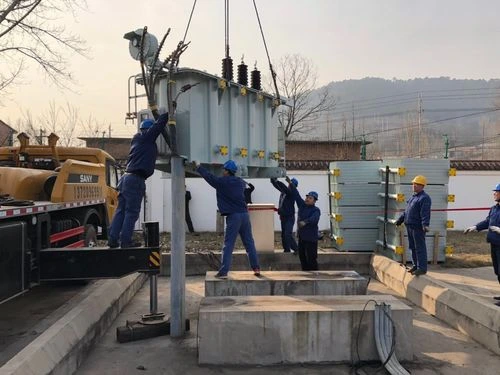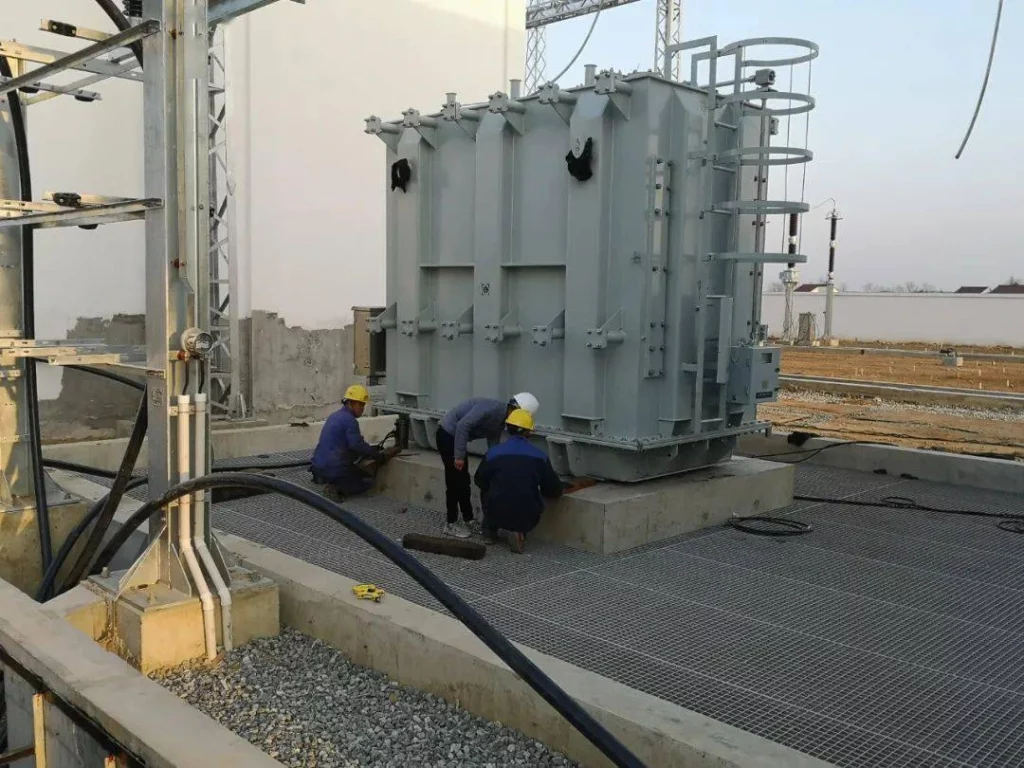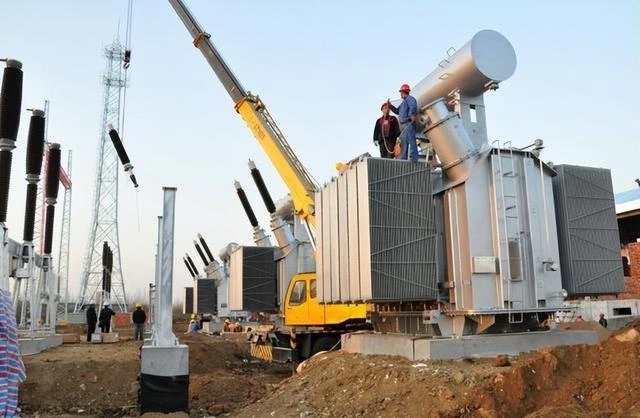
How to Choose Pad Mounted Transformer?
Table of Contents Selecting the right pad-mounted transformer requires careful consideration of several critical
ELECTRIC, WITH AN EDGE
Power transformer installation and protection commissioning are crucial for ensuring the safe and efficient operation of the entire power system. In this article, we will explore the different stages involved in the installation and commissioning process, as well as the common problems that may arise and the countermeasures that can be taken to address them.

Power transformers play a crucial role in the transmission, distribution, and utilization of electrical energy. They convert alternating current from one voltage level to another, enabling efficient long-distance power transmission and reducing line losses.
The installation process for power transformers can be divided into three main stages: transportation, pre-assembly inspection, and specific installation steps.

Transportation of the transformer involves either inflatable or oil-filled transportation methods. Both methods require careful monitoring and recording of the gas pressure and insulating oil conditions to ensure the transformer remains in good condition during transit.
Before installation, a thorough inspection must be conducted. This includes checking the foundation, alignment, and center of gravity of the transformer, as well as the consistency of the centerline of the tube sleeve and the closed busbar.
These steps include checking the oil sample assay results, conducting high and low-pressure tests, verifying the gas relay’s functionality, inspecting the opening of the hole for weather conditions, checking bushing elevation seat voltammetric characteristics, and performing measurement and data recording tasks.

Common problems that may arise during transformer installation include:
Loose casing seals
Inadequate oil injection control
Load switch failure
To address these issues, the following strategies can be employed:
Strengthen equipment unpacking inspection
Ensure stable installation and accessory installation
Implement installation technology strategies
The commissioning process involves several tests and checks, including power supply commissioning operation, daily inspection and checking, and periodic transformer inspection.
The commissioning operation process involves four stages: no-load, half-load, full-load, and overall commissioning operation. Each stage is designed to gradually test the transformer’s functionality and ensure that it operates safely and efficiently under various load conditions.
By following these guidelines and procedures, power transformer installation and protection commissioning can be carried out effectively. This ensures the safe and reliable operation of the transformer, contributing to the overall stability and efficiency of the power system.

Power transformers are critical components of the electrical grid, and their protection is crucial to ensure the stability and reliability of the power system. Various protection systems are employed to safeguard transformers from potential hazards.
Overcurrent protection devices, such as circuit breakers or fuses, are employed to protect transformers from excessive current that could lead to overheating, insulation breakdown, or even fires. They detect abnormal current levels and interrupt the power supply to prevent further damage.
Differential protection is a more sensitive and selective method for transformer protection. It compares the incoming and outgoing currents to detect faults within the transformer. When a discrepancy is identified, the differential relay sends a trip signal to the circuit breaker to isolate the transformer from the power system.
To protect transformers from prolonged overload conditions that could cause thermal stress and reduce their lifespan, overload protection is used. This protection system monitors the transformer’s temperature and issues an alarm or trips the circuit breaker when the temperature exceeds the safe operating range.
The Buchholz relay is a gas and oil-actuated protection device that detects internal faults within the transformer, such as short circuits or excessive heating. It triggers an alarm or trips the circuit breaker when a fault is detected, preventing further damage.
Regular maintenance and monitoring of power transformers are essential to ensure their optimal performance and prolong their service life. Some key aspects of transformer maintenance and monitoring include:
Periodic visual inspection of transformers is necessary to check for signs of external damage, such as oil leaks, corrosion, or bushing damage. Any abnormalities should be addressed promptly to prevent further complications.
Regular testing of the transformer’s insulating oil can help identify potential issues, such as moisture ingress or degradation of insulating properties. Analysis of the oil sample can provide valuable information about the internal condition of the transformer and inform maintenance decisions.
Implementing a condition monitoring system for power transformers can provide real-time data on various parameters, such as temperature, oil level, and partial discharge. This information can be used to predict potential failures and schedule maintenance activities proactively, reducing downtime and extending the transformer’s lifespan.
By following proper installation and commissioning procedures, implementing adequate protection systems, and conducting regular maintenance and monitoring, power transformers can operate safely and efficiently, contributing to the overall stability and reliability of the power system.

Power transformers are designed to have a long service life, with many capable of operating for 30 to 50 years or more. However, several factors can influence their life expectancy, such as operating conditions, loading, and maintenance practices.
The primary factor impacting the life of a transformer is the aging of its insulation system. The solid and liquid insulation components deteriorate over time, and their degradation rates depend on various factors, including:
Operating temperature: Higher temperatures accelerate the aging process of the insulation materials, reducing the transformer’s life.
Loading: Overloading a transformer results in increased heat generation and accelerates the aging process.
Moisture and impurities: The presence of moisture and impurities in the insulating oil can accelerate the degradation of the insulation system.
Implementing strategies to extend the life of power transformers can help utilities to minimize costs, optimize asset utilization, and reduce the environmental impact associated with the disposal of aging transformers. Some of these strategies include:
Load management: Ensuring that transformers operate within their design limits helps reduce thermal stress and prolongs their life.
Improved cooling systems: Upgrading or maintaining cooling systems can help maintain the transformer’s temperature within the optimal range and reduce the rate of insulation degradation.
Regular maintenance: Performing regular maintenance, such as oil analysis and visual inspections, can help identify potential issues before they lead to significant damage.
Retrofitting and refurbishment: In some cases, refurbishing or retrofitting aging transformers can extend their service life by replacing worn or damaged components and upgrading the insulation system.
Power transformers have environmental impacts that should be considered during their lifecycle, including the use of insulating oil, potential noise pollution, and the disposal of decommissioned units.
The insulating oil used in transformers can pose an environmental risk if it leaks or spills. To minimize this risk, it is essential to monitor the transformer’s oil levels, ensure proper containment measures are in place, and dispose of used oil in an environmentally responsible manner.
Transformers can generate noise during operation, which can be a concern in populated areas. Measures to mitigate noise pollution include installing acoustic barriers or enclosures, using low-noise transformers, or placing transformers in underground vaults.
When transformers reach the end of their service life, they should be decommissioned and disposed of responsibly. Many components, such as the metal core, copper windings, and insulating oil, can be recycled or repurposed, reducing the environmental impact and waste associated with transformer disposal.
The power transformer industry has seen several advancements in recent years, driven by factors such as the need for increased efficiency, reliability, and sustainability. These innovations include improvements in materials, design, and monitoring systems.
New insulation materials have been developed to improve the thermal and electrical performance of transformers, leading to increased efficiency and longer service life. For example, high-temperature superconducting (HTS) materials can be used to create windings that offer superior electrical performance and lower losses compared to conventional materials. Additionally, advanced solid insulation materials such as Nomex can provide enhanced thermal stability and increased resistance to moisture and chemicals.
Power transformers are increasingly integrated with smart grid technologies, enabling utilities to monitor and control their assets more effectively. This integration facilitates the use of advanced monitoring systems, including sensors that measure parameters such as temperature, oil quality, and bushing status. These systems can provide real-time data to utilities, enabling them to optimize their transformer maintenance programs and quickly detect potential issues before they lead to significant damage or outages.
Power transformer designs have evolved to address the specific requirements of modern electrical systems. For example, transformers with amorphous metal cores have been developed to significantly reduce no-load losses, improving overall efficiency. Additionally, compact and modular transformer designs have emerged, allowing for easier installation and transportation, especially in urban areas where space is limited.
Advanced cooling systems have been developed to maintain optimal operating temperatures for transformers, reducing the thermal stress on insulation materials and increasing their service life. These cooling systems may include natural or forced-air cooling, forced-oil cooling, or phase-change cooling using materials that absorb heat during phase transitions. In addition, advanced cooling techniques such as heat pipes and thermosiphons can be employed to improve heat dissipation without increasing the transformer’s size.
The power transformer industry is likely to see further advancements in the coming years, driven by the increasing demand for clean and reliable energy. Some future trends include:
As the share of renewable energy sources in the global energy mix continues to grow, power transformers will play a vital role in integrating these resources into the grid. This integration may require the development of transformers with specialized designs and advanced materials that can handle the unique challenges posed by renewable energy systems, such as fluctuating power output and voltage variations.
The concept of smart transformers is gaining traction, as these devices combine advanced power electronics, control systems, and communication technologies to actively manage power flows and respond to changes in grid conditions. Smart transformers can help improve grid stability and reliability while enabling more efficient use of distributed energy resources such as solar panels and energy storage systems.
The digitalization of power transformers will continue to advance, with increased adoption of sensors, communication systems, and data analytics technologies. The integration of Internet of Things (IoT) devices and machine learning algorithms can enable predictive maintenance, optimize asset utilization, and improve overall grid reliability and efficiency.
By staying informed about these technological advancements and future trends, utilities and other stakeholders can make strategic decisions to ensure the continued safe, efficient, and environmentally responsible operation of power transformers throughout their service life.
As the world moves toward decentralized and community-based energy systems, power transformers will play a crucial role in facilitating the integration and management of these systems. In decentralized energy systems, power generation is distributed across multiple locations rather than concentrated in large power plants. These systems often include various types of renewable energy sources and energy storage devices, creating a more resilient and sustainable energy infrastructure.
Transformers designed for decentralized energy systems may need to be more flexible and adaptable to handle varying energy generation levels and changes in demand patterns. Furthermore, they will require advanced communication and control capabilities to work seamlessly within microgrid and distributed energy resource management systems.
The increasing reliance on digital technologies in power transformers will lead to further advancements in monitoring and diagnostic tools. These tools will help utilities and other stakeholders to track and evaluate the performance of their transformers in real-time. Advanced monitoring systems may include online dissolved gas analysis (DGA), partial discharge monitoring, and bushing monitoring, among others.
By continuously monitoring the health of transformers and analyzing their performance data, utilities can proactively address issues before they escalate into more severe problems or cause service disruptions. This can lead to more efficient use of resources, reduced maintenance costs, and improved reliability of the power grid.
Energy efficiency and loss reduction will continue to be a primary focus in the development of power transformers. As global energy demand increases and concerns about climate change grow, the need for highly efficient transformers that minimize energy losses becomes more critical.
Innovations in transformer core materials, such as the adoption of amorphous metals and nanocrystalline alloys, can significantly reduce core losses. Similarly, improvements in winding materials, such as high-temperature superconducting materials, can lead to reduced copper losses. These advancements, combined with optimized transformer designs and advanced cooling systems, will contribute to the development of more energy-efficient transformers that can help minimize the environmental impact of electricity transmission and distribution.
As power transformers become more integrated with digital technologies and communication networks, ensuring the resilience and cybersecurity of these critical assets becomes increasingly important. The integration of advanced control systems, IoT devices, and data analytics can also expose transformers to potential cyber threats.
Utilities and other stakeholders will need to invest in robust cybersecurity measures to protect their transformers and associated communication systems from unauthorized access and cyberattacks. This may include the development of secure communication protocols, intrusion detection systems, and regular security audits and assessments. By prioritizing cybersecurity and grid resiliency, utilities can safeguard their transformers and maintain the reliable operation of the power grid.
In summary, the future of power transformers will be characterized by ongoing advancements in materials, designs, monitoring systems, and digital technologies. By staying informed about these developments and adapting to emerging trends, utilities and other stakeholders can ensure the continued safe, efficient, and environmentally responsible operation of power transformers in an increasingly complex and dynamic energy landscape.
In summary, with the continuous development of power enterprises, power transformer installation, commissioning and other work began to attract attention and attention. In the power system, transformer installation and commissioning is a very important work, because the transformer for scientific and reasonable installation and commissioning, in order to lay the foundation for the people’s electricity safety, in order to make the transmission efficiency is improved.
Therefore, in the installation and commissioning work should be serious, pay attention to each link, so that the installation and commissioning quality can be improved, in order to provide security for the further development of the system. In conclusion, transformer installation and commissioning work is a job worthy of the attention of electric power enterprises, should focus on the optimization and adjustment in the usual work, which is of great significance to the future development of enterprises.
Download Resource

Table of Contents Selecting the right pad-mounted transformer requires careful consideration of several critical

The primary function of the pad mounted transformer is to serve as a critical distribution

A pad mounted transformer operates through electromagnetic induction, serving as a crucial distribution component that